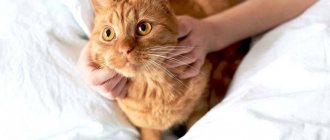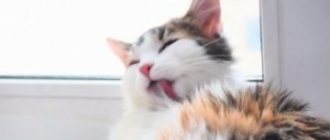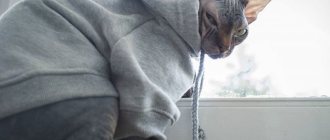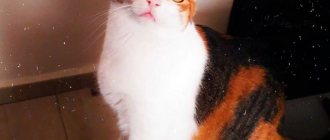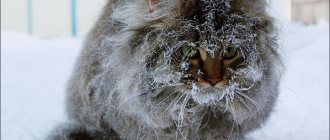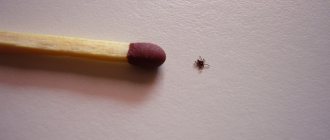24049Administration
5
A pet's illness always brings owners a lot of worries and troubles. A cheerful and mischievous pet suddenly becomes sad and lethargic - this is familiar to many. What if a cat vomits white foam? From a medical point of view, the gag reflex is considered as a natural physiological process that helps the animal empty its stomach.
There may be several reasons that provoke white vomiting. If white foamy vomiting in a cat is repeated many times, this may indicate some kind of disease and cannot be avoided without the help of a veterinarian.
Natural Causes of White Vomit
The cat vomits foam with saliva during protective reactions of the body associated with:
- with trichobezoars - accumulation of hairballs in the stomach, which the animal absorbs while licking and regurgitates to release it;
- foreign bodies - in transparent vomit you can find an object eaten by a cat;
- eating grass or indoor plants - the plants irritate the stomach, the pet burps them and begins to diarrhea;
- stress - nervous overstrain leads to the fact that the pet can vomit;
- estrus and sexual heat - loss of appetite, increased anxiety triggers protective mechanisms;
- motion sickness - travel in transport is a common source of illness in pets.
If a cat vomits, this does not always indicate some kind of disease.
Important! The physiological phenomenon does not cause additional symptoms, the cat continues to move actively and eat calmly. It occurs 1-2 times and goes away on its own.
First aid for a cat
Regidron helps reduce the intensity of vomiting.
If you are sure that the cat does not suffer from serious diseases, and there are no problems other than vomiting, then you can cope with the situation yourself
:
- Put the cat on a one-day fasting diet
. Over the course of a day, the digestive system will be unloaded, and the body will begin to “come to its senses.” After this time, vomiting should stop. Now you can little by little, but often, feed your pet rice boiled in chicken broth. It is better to start with minimal portions every 2-3 hours. In subsequent days, portions increase, but the number of meals decreases. - Brew mint.
You can use pharmacy tea. The broth should be cooled to 37 degrees and poured into the cat’s mouth. One tablespoon of decoction is enough. You can give it either immediately after vomiting or after several hours. - If your cat often swallows fur, you can give him a teaspoon of vegetable oil 3 times a week.
Causes of vomiting in cats and kittens
Cat vomits yellow liquid with foam
Common factors that cause cats to vomit white foam include not enough or too much food, uremia, and drug poisoning. Each of them has additional clinical signs that the pet owner should pay attention to.
Vomiting with drooling may be due to poisoning
Fasting or overeating
Pets that have undergone spaying or neutering procedures no longer have control over the amount of food they eat. The symptoms are complemented by pieces of overcooked food in white foam. Rapid absorption of food without worry ends with its removal through the nasal passages and oral cavity. Overeating can be determined by mucous contents, large food particles, white foam, and diarrhea.
Prolonged fasting in cats causes a protective reflex due to the body's attempts to get rid of accumulated gastric juice. It irritates the mucous membranes of the stomach, causing reverse peristalsis.
Note! A phenomenon called a hungry gag reflex is observed in cats that careless owners do not feed for more than 48 hours.
Uremia
Cats also vomit foam in cases of renal failure accompanied by uremia. Clinical signs of uremic syndrome are presented:
- drowsiness;
- weakness;
- refusal to communicate;
- a sharp decrease in body weight;
- lack of appetite;
- bad breath.
Animals suffer from a persistent increase in blood pressure, anemia and acid-base balance disorders.
For your information! Cats diagnosed with the disease are registered with a veterinarian and take certain medications for life.
In case of drug poisoning, your pet urgently needs help
Drug poisoning
Non-standard reactions may appear during the treatment or prevention of certain diseases. A cat may vomit when taking:
- potent antibacterial drugs;
- laxatives for constipation;
- medicines against helminths.
Important! Self-medication with any medications can provoke a pathological condition.
Causes
Cats, unlike other pets - dogs, have a more developed lower esophageal sphincter, which separates the esophagus and stomach. This cardiac sphincter functions as a kind of valve, allowing fluid and food to pass into the stomach from the esophagus, and also does not release gastric juices back into the esophagus.
In cats, this valve works in two directions, which is associated with their physiology. The appearance of vomiting is an important protective mechanism responsible for the immediate cleansing of unnecessary contents in the stomach.
There may be several reasons why a cat vomits white foam and they are divided into physiological (natural) and pathological (caused by disease). Natural causes of vomiting in a cat include:
- Trichobezoars are balls of hair that form in the pet’s stomach as a result of careful licking. Over a certain period, the cat’s stomach becomes insufficient for the formed balls and vomiting with white foam may occur. This means that the body begins a natural self-cleaning procedure. This phenomenon can be avoided by giving your pet a special paste for prevention.
- Binge eating . Foam vomiting can often occur in animals that are fed dry food without free access to drinking water. Dry food pellets swell in the cat's stomach, causing overflow. The occurrence of vomiting is triggered by cleansing the stomach of excess food.
- Hunger. Cats are unusually sensitive to long periods without food. The fact is that regardless of whether there is food in the digestive system or not, gastric juice and other enzymes necessary for digesting food continue to be produced. Gastric juice, which contains mainly hydrochloric acid, greatly irritates the walls of the organ and if the animal does not eat anything for a long period, it may vomit with white foam.
- Entry of foreign objects into the digestive tract . If a foreign object is stuck in the mouth or pharynx, the resulting vomiting often leads to self-cleansing of the body. If foreign bodies get deep into the digestive system, then it is impossible to do without the intervention of a veterinary specialist. Surgery may be required for intestinal blockage.
- Gestation period for kittens . The hormonal levels of pregnant cats change, just like in women. Therefore, the occurrence of nausea and vomiting in a cat bearing kittens should not cause concern to the owner. If the vomiting is prolonged and debilitating, then in this case it is necessary to consult a specialist. The appearance of vomiting with white foam can also occur in the last weeks of pregnancy. This is due to the sharply increased size of the uterus with fetuses, as well as its pressure on all internal organs.
- The period of sexual hunting . The onset of estrus in cats is accompanied by serious changes in the body. The cat may stop eating and be constantly nervous and anxious. In some cases, the peak of sexual heat is accompanied by vomiting with saliva and white foam.
- Taking medications . If a cat is vomiting with white foam, then the cause may be taking medications prescribed by a veterinarian to treat the disease. Nausea can be caused by antimicrobial agents, as well as medications intended to enhance peristalsis and loosen stools (in the treatment of constipation).
In addition to natural factors that provoke the appearance of white foam vomiting in cats, there are a number of diseases and developmental abnormalities. At home, it is not possible to accurately diagnose and determine the presence of physiological or pathological vomiting and cannot be done without a qualified specialist.
Pathological conditions that provoke vomiting in domestic cats are:
- Infectious lesions. A large number of diseases of viral or bacterial etiology can lead to serious disorders and complications in the body. One of the signs of rabies, feline immunodeficiency, panleukopenia or herpes virus infection is vomiting. In addition to white foam during the eruption of gastric contents, infectious diseases are characterized by a sharp deterioration in the pet’s health, an increase in body temperature, excessive salivation, general lethargy and apathy. If a cat vomits pink liquid with foam, you need to sound the alarm, since the pink color is provided by an admixture of blood.
- Diseases of the digestive system . Various inflammatory processes in the stomach, pancreas, and duodenum, especially in advanced cases, lead to disturbances in the animal’s appetite, stool disorders, and severe weight loss. Vomiting occurs with yellow foam (with pathological processes in the gallbladder), pink foam indicating the presence of blood in ulcerative lesions of the stomach and duodenum.
- Helminthiasis . Infection with parasitic organisms cannot be avoided. Severe infestation caused by tapeworms, or other types of worms, leads to serious disorders in the animal’s body. Helminthic infestation is accompanied by the appearance of alopecia (hair loss), the appearance of diarrhea, alternating with constipation, changes in appetite, vomiting with white foam, and in some cases with adult helminths.
Vomiting in a pregnant cat
The cat is vomiting bile and doesn’t eat anything: what to do?
Toxicosis in a cat is a normal physiological phenomenon. Sharp changes in hormonal balance associated with conception and subsequent development of the fetus cause attacks in the first weeks of gestation. In the last stages of pregnancy, the appearance of white foam in the vomit indicates the maximum volume of the uterus and its pressure on the digestive organs.
Note! The physiological phenomenon in the cat does not affect the appetite and general condition. The animal feels good and behaves adequately.
Diagnostics
Since there are many possible causes of vomiting in cats, a veterinarian will not make the correct diagnosis from just one general examination of the patient. The cat may also be prescribed:
- Blood tests. Blood biochemistry – to evaluate the functioning of the cat’s liver, kidneys and pancreas. Blood clinic – to exclude leukopenia in panleukopenia.
- Ultrasound - to evaluate the structure of the intestines, pancreas, gastrointestinal motility, exclude tumors, assess the size and structure of the kidneys - changes in any of these parameters can cause vomiting.
- X-ray - to exclude foreign objects in the gastrointestinal tract, tumors, fecal retention as causes of vomiting.
- Gastroscopy - examination of the inner surface of the stomach and esophagus, as well as taking an analysis of tissue from the stomach wall to diagnose gastritis, tumors and ulcers in the stomach, often accompanied by vomiting.
- Stool analysis for panleukopenia.
- Fecal analysis for giardiasis.
Video of an ultrasound of a cat who was vomiting white foam.
Causes of vomiting in kittens
Diarrhea and vomiting in a cat: what to do at home
A baby may vomit due to the following factors:
- with a sharp change in the usual diet, especially during weaning from mother’s milk and transition to solid food;
- prepared food of low quality or feeding scraps from the master's table: fatty, smoked, salted, spoiled foods, due to which the stomach is automatically cleansed;
- absorption of food in large pieces (observed in hungry kittens);
- accumulation of fur in the gastrointestinal tract during active licking;
- swallowing foreign objects. Any inedible things become a source of problems and can cause pink vomit;
- poisoning - consumption of medications, detergents, cosmetics, alcoholic beverages or cat litter;
- after vaccination.
Important! Regardless of the source of the kitten's gag reflex, it is necessary to show it to a veterinarian. In complex cases, the problem may be associated with liver diseases, pancreatitis, triaditis, and infectious diseases.
If vomiting...
...caught a pregnant cat
Then, first of all, classic toxicosis is meant. There is no cause for concern if vomiting is rare in the morning, and the vomit consists of food and small impurities of whitish foam. But you can also see a veterinarian, because... in the second half of pregnancy, problems may arise in the gastrointestinal tract due to increased pressure from the enlarged uterus.
...contains undigested food
there may be several reasons:
- bad food;
- the cat ate too much;
- stomach problems;
- obstruction of the stomach or intestines.
The most worrying moment is overeating. After such vomiting, the cat feels quite normal, adequate, remains active, can go for a drink, etc. In all other cases, the animal will require help. Especially if the cat vomits almost immediately after eating undigested food (stomach atony or intestinal blockage).
... flows like a fountain
If it gushes like a fountain, then the first thing it may indicate is a complete blockage of the gastrointestinal transit, and this is a direct path to the hospital. In this case, vomit is erupted under pressure in a strong stream and over a considerable distance. A similar effect is caused by high intracranial pressure and some brain diseases (blood clots, tumors, encephalitis).
…plus other worrying symptoms
If vomiting and diarrhea, plus are accompanied by changes in body temperature in any direction, depression, lack of appetite, rapidly developing exhaustion and dehydration, discharge from the eyes or nose, then we can talk about severe infectious diseases. Only a doctor can make an accurate diagnosis, based not only on anamnesis, but also on additional studies (blood, stool, vomit, etc.).
First aid for an animal
Supportive measures depend on the root causes of deterioration in health:
- in case of poisoning - activated carbon is crushed, dissolved and given to the pet using a syringe (1 tablet per 10 kg of weight);
- in case of paroxysmal short-term vomiting, balance is restored with rehydron solution;
- a weakened pet is supported with injections of ringer's solution, atoxil and enterosgel.
Important! If such a condition in a cat continues for more than 48 hours, then it must be taken to the veterinarian. Further self-medication can lead to the death of the animal.
In any critical situation, it is better to show the animal to a veterinarian
How can the owner help?
Any measures to help a cat with vomiting at home can only be carried out if:
- the animal looks clinically healthy in appearance,
- vomiting was one-time,
- vomiting is no longer accompanied by any additional symptoms.
In all other cases, you should contact a veterinarian for help!
If a cat has a one-time vomiting, which is not accompanied by any further symptoms, and the vomit does not contain any foreign or alarming impurities, then the cat does not need to provide any special help.
After vomiting, you need to let the stomach “rest”, so it is advisable not to give the cat any food or water for 8-12 hours. To quench thirst, you need to prepare ice cubes and let your cat lick them to eliminate the possibility of vomiting water. After the specified time has passed, there is no more vomiting, the cat can be given something to drink.
If the water also does not cause any adverse reactions, you can start feeding. The first day it will be slimy porridge and lean boiled meat and fish. From the second day the cat can be fed as usual.
Mandatory visit to the veterinarian
A visit to the animal clinic is necessary for prolonged illness, severe lethargy, or weakness of the pet. If a cat cannot go to the toilet and does not allow her to touch her stomach, then she needs urgent help. Other reasons to contact a veterinarian include:
- frequent attacks, up to several times per hour, subject to a fasting diet;
- complete denial of food, foamy vomit can be a symptom of a serious illness;
- high temperatures, in the range of 39-39 ° C, at which the cat shakes;
- convulsive syndrome - involuntary muscle contractions indicate damage to the central nervous system;
- blood particles in the vomit, diarrhea.
Regular regurgitation of hair indicates a digestive disorder. There is a possibility that the source of the pathological condition is a disease of the gallbladder, rectum or pancreas. When the liver and bile ducts are damaged, the cat begins to drool and vomits yellow contents.
Important! Ignoring the pathological deviation leads to dehydration of the animal's body. Violation of water balance and active removal of useful substances can be a prerequisite for death.
What to do?
To begin with, if a cat is vomiting, it is necessary to rule out poisoning or infection and this must be done as soon as possible. Then the nature of vomiting is revealed
. If you are vomiting with worms, go to the hospital immediately for treatment. Vomiting with food indicates overeating; nausea during sterilization is considered normal, but only when there are no other signs; vomiting in the morning indicates a gallbladder infection.
Prevention is considered to be compliance with the rules of housing and feeding. Try to eliminate dry food when your cat has stomach problems. If the cat is picky and does not eat anything other than it, then try making it with boiling water, which will make the food softer. If cats eat wallpaper, it is necessary to provide them with a toy. That is, knowing why a cat is vomiting, you will no longer think about what to do, and will immediately take measures to alleviate the condition of your pet.
Update: September 2018
Cats have a very sensitive vomiting center, so owners of mustachioed pets experience cat vomiting many times more often than in other animals. In this unsightly way, the cat not only gets rid of something inedible, this process may also indicate that the animal is seriously ill.
Diagnosis and treatment
A consultation with a veterinarian begins with a medical history. The doctor asks about the pet’s diet, the time of onset of symptoms, and the presence of chronic diseases or infections. A visual examination, palpation of the abdomen and information received from the cat's owner are necessary to make a preliminary diagnosis. Its confirmation is carried out using laboratory diagnostic examination:
- blood, urine, vomit tests;
- Ultrasound of the abdominal organs and kidneys.
After the final diagnosis is made, the sick cat is prescribed a specific therapy regimen. This includes taking medications and restoring lost fluid.
Anti-vomiting medications for cats
Medications are prescribed by a veterinarian after determining the source of the gag reflex. Frequently used tools:
- cerukal and torekan help get rid of nausea and are safe and effective medications with central action;
- famotidine, omeprazole are necessary to reduce the production of hydrochloric acid;
- Heptral, Chofitol, Essentiale belong to the subgroup of hepatoprotectors, recommended for liver pathologies;
- Smecta, Enterosgel are sorbents prescribed for poisoning.
Some animals are prescribed antispasmodics to suppress pain. Therapy is carried out with papaverine, drotaverine, baralgin, platyphylline.
Use of antibiotics
Antibacterial therapy is prescribed for diagnosed inflammatory processes. Additionally, multivitamin complexes and immunostimulants are prescribed. It is carried out:
- ampicillin;
- streptomycin;
- amoxicillin;
- amoxiclav;
- azithromycin.
Medicines are given in tablets, capsules or injectable solutions. The duration of the course and dosage are determined by the attending physician.
For your information! Antibacterial therapy carried out independently provokes serious complications. Antibiotics in the wrong dosage negatively affect the pet’s heart, liver and kidneys and disrupt the normal microflora of the gastrointestinal tract.
Diet food
If pathology occurs, animals are prescribed therapeutic fasting for the first 12 hours. To replenish the loss of water and electrolyte balance, the pet must have free access to water. He should drink without restrictions, but he cannot be forced. Otherwise, the cat will begin to vomit and vomit water.
Subsequently, he is transferred to a specialized medicinal food intended for cats with digestive problems. Preference is given to canned varieties; hard varieties are more difficult to cope with in the affected gastrointestinal tract. The transition to a normal diet occurs gradually and only with the approval of a veterinarian.
Important! During therapy, the animal should be at home, even if it wants to go for a walk.
Free access to water should be maintained throughout the course of treatment
How to treat and diagnose a cat's vomiting white foam?
The veterinarian will definitely conduct a visual examination and palpation of the cat’s abdominal cavity. Since there are many reasons that provoke vomiting, additional laboratory examinations - blood tests, general and biochemical urine tests. They allow you to assess the condition of internal organs, as well as confirm or exclude feline distemper.
To exclude
panleukopenia and giardiasis, it will be necessary to conduct a microbiological examination of stool.
An abdominal x-ray is used to identify foreign bodies in the gastrointestinal tract, tumors, intestinal obstruction or coprostasis.
Ultrasound allows you to evaluate the structure of the kidneys, intestines, pancreas, intestinal motility and blood flow in the kidneys.
If the veterinarian suspects gastritis , an ulcer or a tumor in the stomach , then gastroscopy . With its help, the mucous membrane of the esophagus and stomach is examined, and a biopsy of the tissues of these organs is performed.
Therapeutic measures if the cat vomits white foam frequently
If your cat has vomited once or twice and remains alert and active, there is no need to worry.
Sometimes cats themselves look for grass to eat it and induce vomiting, thus clearing the stomach of accumulated hair.
In case of a normal stomach upset, the pet
should be stopped feeding, but not limited in drinking.
Short-term fasting for up to 12 hours helps the body cope with disorders on its own.
The next day, the animal is often and little by little fed rice or oatmeal porridge in chicken broth. When the cat does not get better and the vomiting does not stop , but rather intensifies, other symptoms of ill health appear - diarrhea, fever, lethargy, blood in the vomit, etc., put everything aside and seek help from a veterinarian, since self-medication is no longer effective.
The veterinarian can prescribe the following medications and therapeutic measures for your cat:
- if the animal does not eat and the vomiting does not stop, the doctor will prescribe drips with solutions of electrolytes and glucose, which will restore the level of fluid and important elements in the body;
- a foreign body detected in the digestive tract will most likely require surgical removal or the use of a gastroscope;
- gastroprotectors are used to protect the gastric mucosa from damage produced by hydrochloric acid;
- Antibiotics are often prescribed to treat inflammation in the intestines;
- Antiemetics are used to suppress the gag reflex.
Medicines alone are not enough; a special diet is also required
Low in fat and high in fiber, it helps cleanse the body of toxins and improve gastrointestinal motility.
Kittens require special attention
and young animals up to a year old, since they have a small margin of safety and digestive diseases cause more serious consequences in them than in mature, strong cats.
Prevention to prevent your cat from vomiting white foam
If rare, cleansing vomiting is not a pathology that needs to be dealt with, then painful causes of vomiting can and should be prevented. Carrying out preventive measures is easier and cheaper than treatment. And the help of a veterinarian will not be superfluous here either.
- Veterinarians-gastroenterologists recommend to prevent vomiting in cats:
- Attend routine checkups, this is especially important for older cats.
- Carry out scheduled dewormings once a quarter.
- Vaccinate kittens and cats according to the vaccination schedule.
- Feed your pet healthy food without homemade delicacies.
- Make sure that the cat does not take or swallow small and dangerous objects: toys, threads, needles, foam rubber, bones, etc.
- Brush your long-haired cat often so that less hair gets into its stomach and intestines.
- Exclude raw meat, fish, and offal from food - a source of infection with parasites and protozoa.
The veterinary will help you cope with any digestive problems of mustachioed pets. If treated early, your pet can be back on its feet in a matter of days. Don’t risk his health - call the center for a consultation with a veterinarian, which, by the way, is completely free. If necessary (no time, no transport, late hour), you can call our doctor at home at a time that suits you, around the clock.
We respond to an average of 800 calls per month, which proves that veterinary care at home is necessary and important for our clients, especially in urban living conditions. After an appointment at home, the doctor stays in touch with you and monitors the recovery process, prescribing tests, changing the treatment regimen, diet, and so on, as long as necessary. You can find out prices and services on the website or by calling us. Call us and we will be happy to answer all your questions!
Carrying out prevention
Prevention of sudden attacks of the gag reflex is carried out with the help of:
- regular anti-worm therapy. For cats walking outside every 3 months;
- annual vaccinations, preventive examinations at a veterinary clinic for timely detection of hidden diseases;
- proper nutrition. Balanced ready-made food in sufficient quantities will help avoid pathological conditions;
- pet care. Brushing will prevent the accumulation of hairballs in the stomach;
- maintaining hygiene in the home. A clean room and no small objects that the cat could swallow.
Combing
White foam along with the contents of the stomach can have both physiological and pathological origin. The appearance of accompanying clinical signs requires seeking professional help and undergoing a full diagnostic examination. Timely treatment will avoid complications and save the life of your pet.
Is it possible to prevent vomiting?
No pet is immune from vomiting, but it is quite possible to follow some rules that can prevent this reflex. Based on the possible causes of vomiting, the following preventive measures follow:
- Feed your cat only fresh and balanced food;
- It is imperative to monitor the amount of food eaten and the frequency of feeding (do not overfeed);
- It is mandatory to carry out annual scheduled vaccinations against infectious diseases;
- worm the cat regularly (once every 3-6 months);
- long-haired cats should be brushed regularly and given special products to help remove hairballs from the body naturally and reduce the likelihood of vomiting hair;
- do not let the cat play with very small objects that it can choke on, and hide them so that the animal does not find them itself;
- be attentive to the health of your pet, noting any deviations from natural behavior in order to detect a state of ill health in time. To do this, regularly show the animal to a veterinarian for a preventive examination, especially if its age has crossed the line of 7-8 years.
Every owner should be attentive to his pet in order to distinguish in time a banal reflex emptying of the stomach through the mouth from a possible serious illness.
Treatment and prevention
If a pet's health worsens, the owner should not treat it themselves. In this case, the risk of complications as a result of incorrectly selected methods and means increases.
An experienced specialist can accurately diagnose and prescribe therapy, taking into account the animal’s condition and the severity of the disease.
Providing first aid to a cat who is vomiting
It is useful for the owner to know what first aid is for a pet.
But any assistance actions can only be carried out under the following conditions:
- the cat looks healthy;
- nausea recurred once;
- there are no additional signs of deterioration in health.
Help may include the following:
- Do not give the animal food or water. Fasting for 24 hours will allow the body to rest and regain strength. To quench your thirst, you can give a piece of ice to lick.
- After a day, you can start feeding him food with a slimy consistency.
- A return to regular food occurs after a couple of days.
- If you suspect poisoning or ingestion of a foreign body, you should induce a vomiting attack. In case of poisoning, such vomiting will only help in the first couple of hours. This will stop the action of toxins, but if a lot of time has passed, they have already entered the bloodstream.
- When worms appear, an antihelminthic drug must be given.
No owner is immune from the deterioration of a pet's condition.
If your health deteriorates significantly, you should immediately contact your veterinarian.
Following simple rules of care will help reduce the likelihood of vomiting attacks:
- feed only fresh food;
- give food in small portions in several doses;
- give preventive vaccinations;
- give antihelminthic drugs annually;
- pets with long hair should be combed with special brushes and given medications to improve the natural elimination of hairballs from the body;
- remove all small objects from reach;
- Periodically visit the veterinarian for a preventive examination.
Be sure to read:
Diarrhea in a kitten: what to do, first aid, causes, treatment, medications and folk remedies
When medical help is urgently needed
If your health deteriorates significantly, you should immediately contact your veterinarian.
Dangerous symptoms may include the following:
- attacks of nausea continue for several days;
- vomiting appears several times a day;
- foreign impurities appear (bile, foam, blood);
- attacks of nausea appear even between meals;
- there are other symptoms - increased or decreased body temperature, diarrhea, discharge from the nose or eyes, weakness.
The doctor examines the animal and asks the owner about all the details of the deterioration of his health condition. Detailed answers allow the specialist to make a diagnosis and prescribe treatment.
In some cases, additional examinations may be performed - ultrasound, gastroscopy, blood tests or x-rays.
Diseases of the gastrointestinal tract and genitourinary system
Most experts believe that the appearance of nausea in pets, as a rule, is a consequence of improper care and nutrition.
If a pet is diagnosed with gastrointestinal pathologies, diet and medications are used.
Depending on the cause of vomiting, the following may be used:
- rehydration preparations to restore the body’s water balance;
- antiemetics to improve well-being;
- antibiotics to fight bacteria;
- sorbents for cleansing of toxins;
- phytotherapy.
In severe cases, surgery is used. With the help of operations, large bezoars, kidney stones, foreign objects are removed, and large injuries to internal organs are sutured.
Why does a cat vomit white foam?
If fur gets into the digestive tract and causes discomfort to the pet, then the animal’s body will start the cleansing process by vomiting. The cleansing will not be completed in one go, but the last meal will come with it.
The lack of leftover food will not stop the gag reflex until all the hairs come out. Therefore, the cat secretes foam, bile and clear liquid. Within a day, this condition goes away, but if the pet does not show signs of improvement, then the cause of vomiting may be the occurrence of diseases, in some cases life-threatening.
In this case, you need to consult a doctor who will find out the reasons and make a diagnosis.
Treatment at home and at the veterinarian
If you notice unusual vomiting in your pet, you should try to help even before you get to the veterinary clinic. It is important to create a comfortable environment at home. Never scold your pet for exhibiting uncontrollable physiological reactions! Carefully monitor the cat, note in a notebook all unusual phenomena and accompanying symptoms - the veterinarian will definitely ask about them.
The bowl should contain clean filtered water at room temperature, but it is better to remove food for a while - especially if you suspect some kind of disease. Protect your pet from the harassment of children and other animals. Prepare a comfortable carrier and a warm blanket for transportation to the clinic (if it’s cold outside).
First aid at home
The very first action is to limit your pet's food intake, unless it is a case of hunger nausea. You should not give food for a day - this will reduce the load on the body. Be sure to carefully examine the vomit to accurately describe everything to the doctor. Ideally, take a photo of them. Observe whether there are accompanying alarming factors: whether the cat behaves restlessly, whether saliva flows, whether complaining sounds are heard, etc.
If your cat is vomiting from hunger, offer him a very small amount of boiled diet food - chicken or beef broth, a little wet food. Start with one tablespoon of food, then gradually, over two days, increase the portion to the usual one. At this time, the interval between feedings should be minimal - up to 3 hours.
During a fasting diet, water should be freely available. You should only use bottled or filtered liquid - tap water will only cause more harm. If the condition stabilizes, then you can give a little boiled rice.
If nausea continues, administer first aid to prevent dehydration. Most likely, the veterinarian will recommend the following over the phone:
- Give the cat activated carbon in a ratio of 1:10, that is, a tablet per ten kilos of weight. Observe all proportions strictly. Dilute the tablet in water and inject it into the mouth from a large syringe, after removing the needle. This will help if nausea occurs due to poisoning.
- If the attacks are short-lived, then you can give the furry patient Regidron solution.
- Dehydration can be prevented with the help of medications Enterosgel and Atoxil - but the dosage should be checked with a veterinarian by phone.
- If the cat is very weak and does not want to take liquid, then you need to inject Ringer's solution.
- If you suspect that the animal has eaten a small object, then you need to provoke a gag reflex. You can prepare a saline solution: to do this, mix one tablespoon of salt in 1 glass of warm water. Give your pet a drink until the urge to feel sick appears.
If the animal’s health does not stabilize within a couple of days, then you should immediately take it to a veterinary clinic.
Going to the veterinary clinic
Treatment for a cat vomiting white foam begins with an examination at a veterinary hospital. Tell the doctor all the information about your pet and its condition, when you began to notice such phenomena, and whether there are any chronic diseases. To make a correct diagnosis, you will need a thorough examination of the animal, laboratory tests, ultrasound of the abdominal cavity and kidneys. Based on the results, the veterinarian will establish a treatment regimen: it usually includes drug therapy and the parallel elimination and prevention of dehydration.
It is impossible to say in advance what medications the veterinarian will prescribe - it all depends on the primary disease. Infectious diseases will require a course of antiviral and antibiotics along with immunostimulating therapy. In case of poisoning, it is necessary to administer an antidote and detoxify the body. If there are problems in the gastrointestinal tract, the problematic organ is identified and treated.
Don't forget about the special diet. Food should be semi-liquid. It is best to feed small and frequent meals. If you give meat, it must first be boiled and chopped. After everything has stabilized, you can gradually switch to normal nutrition.
Cat vomits white due to illness
Please note! Symptoms of vomiting in a kitten can indicate a hundred different diseases and abnormalities. It is possible to cure a pet only if the root cause of the gag reflex is accurately established, so you cannot do without a good veterinarian.
White vomiting, as one of the symptoms, is associated with many feline pathologies and diseases:
- Surgical interventions . If the pet has undergone surgery under anesthesia, then often after this the cat experiences attacks of white vomiting and foam from the mouth and nose. After surgery and anesthesia, the animal should remain in conditions of rest and comfort.
- Vaccination . In the modern world, vaccination is the key to a long and healthy life for a cat. Sometimes a consequence of vaccination can be foam and white vomit. Normally, this condition should not last more than 2-3 days in a row.
- Viral infections . Among the most dangerous diseases leading to death are herpes and corona virus infections, rabies, feline immunodeficiency, Aujeszky's disease and panleukopenia. The infectious source is an animal carrier of the virus. Along with white foam and a gag reflex, the pet experiences weakness and refusal to eat, excessive salivation, and an increase in body temperature. One of the most dangerous symptoms is when a cat vomits foam mixed with blood.
- Pathologies of the digestive system . Gastrointestinal diseases in cats always resolve with profuse vomiting and intestinal upset (diarrhea or constipation), severe weight loss occurs with good appetite. In this case, the vomit comes with blood, bile and foam. The animal refuses to eat and drink, and the opposite effect may occur - the pet often eats a lot and actively drinks liquids. The most common of them are ulcers, gastritis and enteritis.
- Helminths . The cat's body is attacked by up to one hundred thousand varieties of worms, which can parasitize the vital organs of the animal. At the same time, the cat exhibits a number of other signs - total hair loss, alternating diarrhea and constipation, changes in appetite and mood, itching in the anus, vomiting with white foam and worms. Against the background of intoxication, immunity decreases, dystrophic changes occur in many internal organs and systems. The animal easily becomes infected and often gets sick, and as a result may even die.
In what cases do we run to the doctor?
Seeing how their pet is suffering, owners are wondering what to do if their cat is vomiting white foam. First you need to make sure that the animal receives enough water. Then you need to observe.
In the following cases, you should also not postpone going to the doctor:
- The animal has lost interest in food. If vomiting with foam is combined with complete indifference to food, then it is necessary to check whether the animal has liver lipidosis.
- Impenetrable thirst. If a kitten drinks water without stopping, then the chances of developing pathologies in the kidneys increase.
- The cat does not urinate in the toilet, although he consumes liquid in the usual volumes.
- Vomiting occurs regularly - more than 2 times within an hour.
- The animal has a high fever and is shaking.
If you do not consult a doctor in a timely manner, then there is a possibility of a phenomenon such as chronic vomiting in cats, which will worsen the situation. Each of the described symptoms is seriously life-threatening, so it is necessary to show the animal to the doctor as soon as possible.
Useful tips from a specialist
To avoid the appearance of unpleasant and dangerous symptoms, experts recommend:
- Brush the fur regularly to prevent it from getting inside. Special brushes are used for combing.
- At the first urge, it is advisable to take the animal out onto the grass, if the weather season permits. Cats eat grass to irritate their stomach so it can empty its contents faster. It is useful to grow grass at home in a pot so that your pet can cleanse the digestive tract at any time if nausea occurs.
- To eliminate liver problems, control your diet and watch portions. For prevention, it is useful to periodically administer medications that normalize liver function.
Causes of illness
Every cat periodically burps its fur. The problem can also occur in hairless breeds adjacent to furry pets. When licking, hair accumulates in the cat's gastrointestinal tract and needs to be released. Do not be alarmed if your cat periodically (1-2 times a week) burps dense hair sausages or balls. Problems are indicated by more frequent vomiting, constipation, lack of appetite, depression and bloating. Symptoms indicate that the stomach and intestines are full of wool.
List of reasons why vomiting in a cat is provoked:
- Poor nutrition. This does not only mean food. Kittens and adults show interest in non-food items such as broomsticks, houseplants, decorative items (such as ikebanas), foil, or Christmas decorations. Some enter the body accidentally during play, others are eaten deliberately. Vomiting of undigested food is a potential sign that the selected food or some product in the diet is not suitable for your pet.
Overeating. A large portion or rapid swallowing of food does not allow the stomach to completely digest it, as a result, the food comes back through the mouth.
Pregnancy. The space for the stomach decreases during pregnancy. Hormonal changes also contribute to nausea.
Age. Problems with food absorption are observed in kittens during the transition to solid food. Vomiting can also be caused by a congenital abnormality of the gastric sphincter, due to which the entire amount of food eaten cannot pass into the intestines. Active games a short time after eating are also a potential cause of malaise. Elderly individuals also suffer from a reflex eruption of gastrointestinal contents, whose body, due to age, is less able to process food.
Poisoning. Stomach cleansing (including diarrhea) is the body's standard defense mechanism when confronted with a toxin. In such cases, pets often feel sick after each meal, their appetite decreases, an aversion to food appears, and a general deterioration in their condition is observed.
Stress. Emotional overload can cause involuntary contraction of the stomach muscles.
Reaction to medications. Involuntary stomach contractions are a side effect of taking a number of medications. Veterinarians who prescribe treatment or instructions usually warn about it. Nausea is also observed after general anesthesia. If the animal vomits shortly after surgery, it means that it has not yet recovered from anesthesia.
Infection. Bacterial and viral infections, such as plague and hepatitis, directly or indirectly affect the functioning of the stomach.
Parasites. Helminths of various types are a common cause of vomiting.
Injuries. Regurgitation of food is caused by damage to the larynx, stomach or intestines. It can be caused by injuries to the brain and other internal organs.
Various pathologies. Vomiting is a possible companion to oncology, liver, kidney and gallbladder diseases, gastritis, pancreatitis and other disorders.
Vomit differs in volume and composition:
- If a cat vomits saliva or a white foamy substance, which is protective stomach mucus, then the animal is vomiting on an empty stomach.
Too dry mass may indicate dehydration.
The color of vomit depends largely on what you eat; greenish, reddish or yellowish substance may be stained by the feed.
Bile and blood will always stand out against the background of food shades. Their presence indicates a serious violation.
The presence of excrement will also indicate a dangerous pathology. This is a sign of intestinal damage.
The mentioned cases of obvious illness require immediate contact with a specialist.
To accurately determine the cause, you will need the help of a veterinarian. The doctor will be able to take initial measures to alleviate the patient’s condition and schedule further treatment in a hospital or at home. In less severe cases, the owner's independent help may be sufficient.
Treating a cat for vomiting
You should not try to stop vomiting on your own - without knowing the true cause, you can cause serious harm to your pet.
When the owner notices that the cat has vomited after sterilization, he may panic, but there is no reason to worry: the cat has undergone anesthesia and is recovering from it, or she was fed early. No treatment required. A one-time case in a cat after vaccination also does not need help.
In case of poisoning, the cat should be given absorbents; if severe poisons are suspected, a veterinarian will be treated.
In any case, you can help your cat with vomiting with drugs that restore the water-salt balance.
The doctor will prescribe a diet and prescribe pills that will protect the cat’s body from another “stomach evacuation.”
Phosphalugel
The gel has a uniform consistency, has a pleasant taste and is white in color. The contents of the sachet are used according to the dosage: for cats, 0.5 ml is calculated for each kilogram of the pet’s weight.
Mezim
Mezim is classified as a human drug approved for ingestion by animals. For treatment, use a quarter of the tablet, which is turned into powder and treated to the kitty 15 minutes before meals.
Cerucal
Cerucal can be purchased in the form of tablets and injections. The dosage is calculated based on the weight of the animal: 0.2-0.4 mg per kilogram of the animal’s weight. Reception is carried out 3-4 times a day.
Smecta
The substance is in the form of a white powder, available in sachets. For a medium-sized adult cat, 1.5 g of medicine is enough. The powder is diluted to a mushy state with boiled water (50 ml).
global $ads_google; //data-ad-slot=”2475549904″ $ads_google = empty($ads_google) ? false : true; ?> if ($ads_google == false) {?>
$ads_google = true; ?> } ?>
You should not leave the process of vomiting in a cat to chance - its owner is responsible for the health of the animal.
